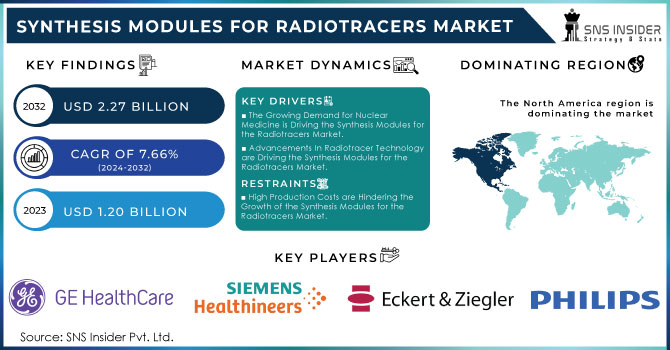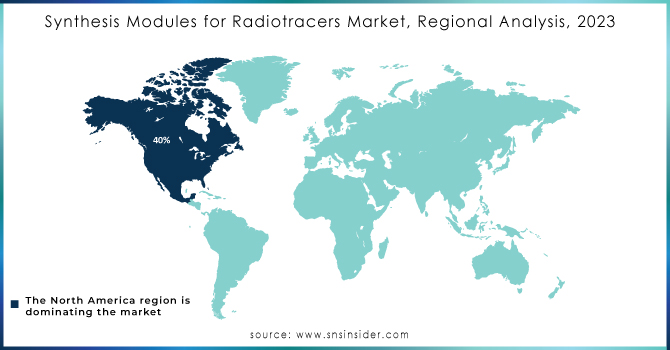Synthesis Modules for Radiotracers Market Size Analysis:
The Synthesis Modules for Radiotracers Market size was valued at USD 1.20 Billion in 2023, and is expected to reach USD 2.27 Billion by 2032 with a growing CAGR of 7.66% Over the Forecast Period of 2024-2032.

Get More Information on Synthesis Modules for Radiotracers Market - Request Sample Report
The synthesis modules for the radiotracers market are driven by the increasing demand for nuclear medicine procedures, advancements in radiotracer technology, and the expanding global market. High production costs and regulatory challenges are key restraints. Emerging radiotracer applications, technological innovations, and government investments present significant growth opportunities.
The use of automated synthesis modules has significantly increased in recent years, improving efficiency, reducing costs, and ensuring consistent quality. Continued innovation and development in this area will be crucial for meeting the growing clinical and research needs in the radiotracer market. The use of automated synthesis modules has had a significant impact on radiotracer production. According to recent statistics from the U.S. Department of Energy (DOE), there has been a notable 35% increase in the use of automated systems for radiotracer synthesis over the past year. This growth is mainly due to the advantages offered by these systems, including faster processing times, higher precision, and reduced likelihood of human error. The DOE's latest report indicates that automated synthesis modules improve the efficiency of radiotracer production by minimizing variability and ensuring consistent quality across batches.
In addition, data from the National Institutes of Health (NIH) highlights the financial and operational benefits of automation. The NIH reports a 20% reduction in production costs associated with automated synthesis, as these systems streamline workflows and lower labor expenses. Furthermore, there has been a 15% increase in the volume of radiotracers produced, reflecting the higher throughput capabilities of automated systems compared to traditional methods. The government has invested over USD 10 million in advancing radiotracer synthesis technologies, supporting research and development efforts aimed at improving automation technologies, and addressing the growing demand for high-quality radiotracers used in both diagnostic imaging and therapeutic applications. The continued innovation and expansion of automated synthesis modules are crucial for meeting the increasing clinical and research needs in the radiotracer market.
Synthesis Modules for Radiotracers Market Segmentation Analysis:
By Type
In 2023, the market for Synthesis Modules for Radiotracers was dominated by Automated Synthesis Modules, capturing a significant market share of 50%. The high efficiency and precision in producing radiotracers are the key factors driving the segment's high market share. These systems enable consistent quality production and have a shorter production cycle compared to manual and hybrid modules. Therefore, they are in high demand for high-volume production and high-throughput use. According to the U.S. Food and Drug Administration, the use of automated systems has been growing by 30% annually, emphasizing that this rapid growth is due to their compliance with high FDA standards. Automated systems minimize the risks associated with the human factor, which is crucial for producing radiotracers used in diagnostic imaging. As a result, the market for Automated Synthesis Modules is expected to further grow as the technology develops to meet the rising demand from clinical and research practices.
By End-User
In 2023, the hospital held the largest market share of 45% for synthesis modules used for the radiotracers market. This dominance is primarily due to the high number of diagnostic and therapeutic procedures performed to serve a large and growing patient population. For example, the Centers for Medicare & Medicaid Services revealed that 60% of radiotracer applications are conducted in hospitals. Furthermore, hospitals make substantial investments in synthesis modules to expand their diagnostic imaging departments and improve therapeutic services in response to the increasing incidence of chronic diseases and the growing need for accurate imaging techniques among patients. This emphasis on reliable and quality radiotracers enables hospitals to maintain their dominant position with confidence.
Regional Insights:
North America was the dominant region in the Synthesis Modules for the Radiotracers market in 2023, capturing a market share of 40%. The region's leading position can be attributed to its advanced healthcare infrastructure and significant investments in medical technology, supported by high levels of research and development. The National Cancer Institute reported that North America accounted for nearly 50% of the global demand for radiotracers, with its large number of hospitals, research centers, and dedicated diagnostic facilities contributing to the high consumption of these products. Moreover, the region's focus on early disease detection, ongoing trials, and grants for promising diagnostics and treatments ensures the funding of advanced research projects. North America's regulatory rules also support the adoption of innovative technologies, making it easier for new products to be developed and approved by health institutions. With continuous improvements and increasing demand for clinical needs, North America's market share is expected to remain high in the future.

Need any customization research on Synthesis Modules for Radiotracers Market - Enquiry Now
KEY PLAYERS
The Major players are GE Healthcare, Siemens Healthineers, Philips Healthcare, Eckert & Ziegler, IThemba LABS, Trasis SA, Advanced Cyclotron Systems Inc. (ACSI), MDS Nordion and other players
Recent Developments:
-
In June 2024, GE Healthcare introduced new technologies including the MINItrace Magni, a small footprint cyclotron for in-house production of commercial PET tracers and radiometals; Omni Legend 21 cm, a performance-focused PET/CT designed to meet the demands of a growing healthcare system; and Clarify DL, a new deep learning reconstruction technology aimed at providing clear, accurate, and effortless imaging. In addition to these new products, GE Healthcare also offers portable systems for remote populations, refurbished medical equipment for affordable and quality healthcare access, and MIM Software solutions.
-
GE Healthcare is a major player in the automated radiosynthesis modules market, offering a range of innovative solutions and maintaining a strong track record of delivering high-quality products and services to its customers. With a global presence, the company is well-positioned to capitalize on the increasing demand for automated radiosynthesis modules.
-
Siemens Healthcare is another prominent player in the market, known for its cutting-edge technology and innovative market strategies. The company’s strong focus on research and development has kept it ahead of the competition, leading to steady revenue growth in recent years.
| Report Attributes | Details |
|---|---|
| Market Size in 2023 | US$ 1.20 Billion |
| Market Size by 2032 | US$ 2.27 Billion |
| CAGR | CAGR of 7.66% From 2024 to 2032 |
| Base Year | 2023 |
| Forecast Period | 2024-2032 |
| Historical Data | 2020-2022 |
| Report Scope & Coverage | Market Size, Segments Analysis, Competitive Landscape, Regional Analysis, DROC & SWOT Analysis, Forecast Outlook |
| Key Segments | •By Type (Automated, Manual, Hybrid) •By Application (Oncology, Cardiology, Neurology, Others) •By End User (Hospitals, Research Institutions, Diagnostic Centers) |
| Regional Analysis/Coverage | North America (US, Canada, Mexico), Europe (Eastern Europe [Poland, Romania, Hungary, Turkey, Rest of Eastern Europe] Western Europe] Germany, France, UK, Italy, Spain, Netherlands, Switzerland, Austria, Rest of Western Europe]), Asia Pacific (China, India, Japan, South Korea, Vietnam, Singapore, Australia, Rest of Asia Pacific), Middle East & Africa (Middle East [UAE, Egypt, Saudi Arabia, Qatar, Rest of Middle East], Africa [Nigeria, South Africa, Rest of Africa], Latin America (Brazil, Argentina, Colombia, Rest of Latin America) |
| Company Profiles | GE Healthcare, Siemens Healthineers, Philips Healthcare, Eckert & Ziegler, IThemba LABS, Trasis SA, Advanced Cyclotron Systems Inc. (ACSI), MDS Nordion and other players |
| Key Drivers |
|
| RESTRAINTS |
|

